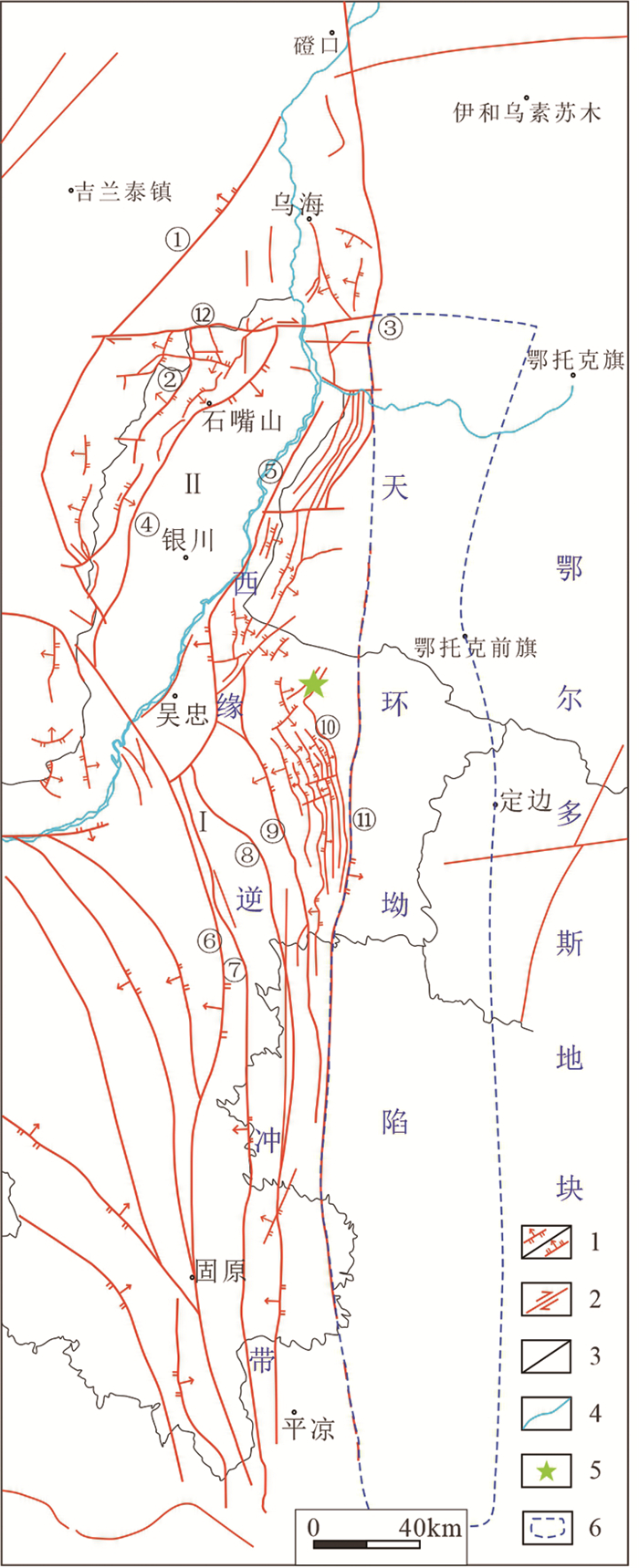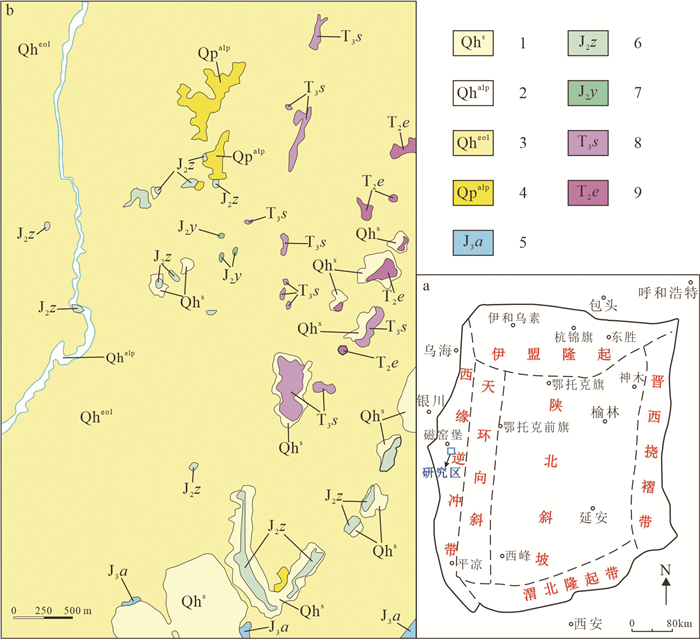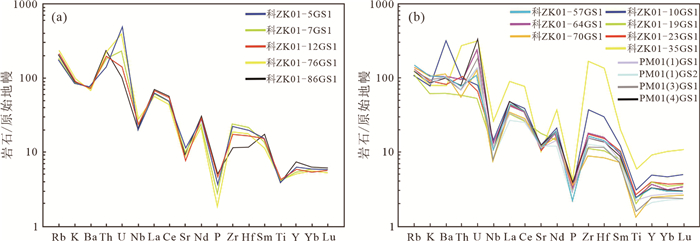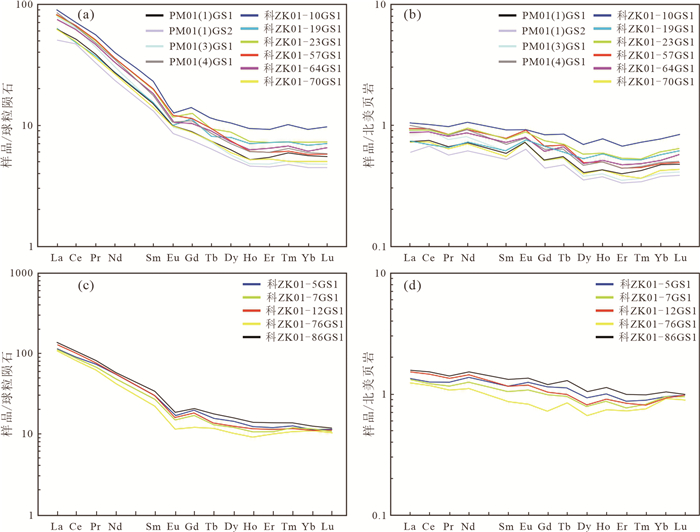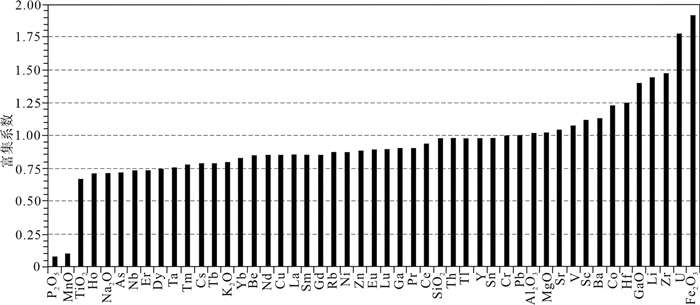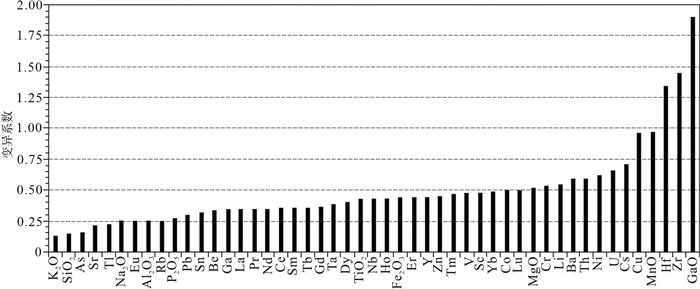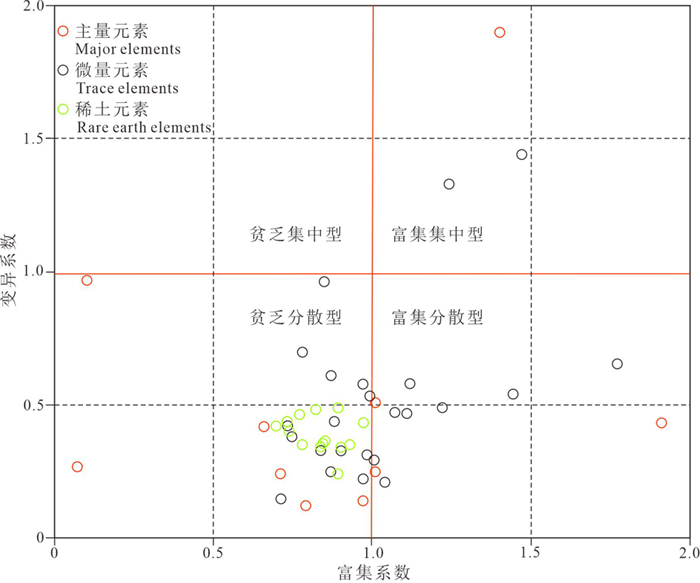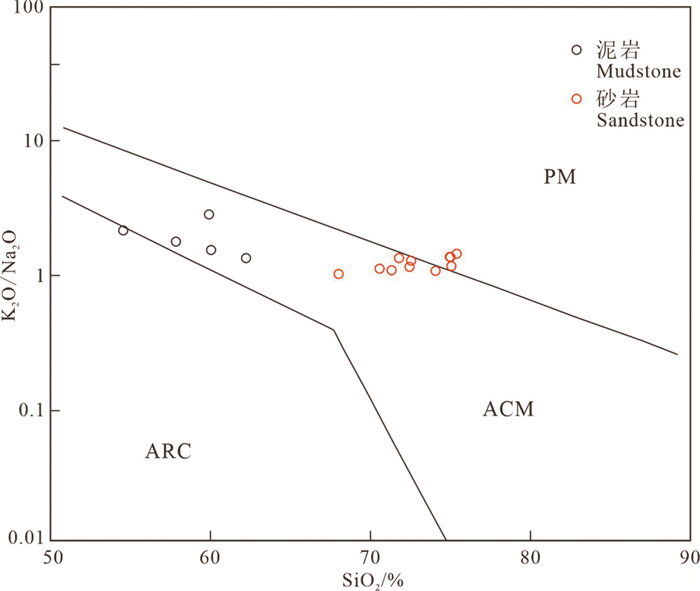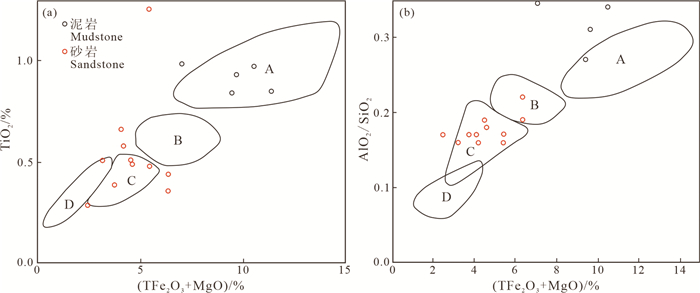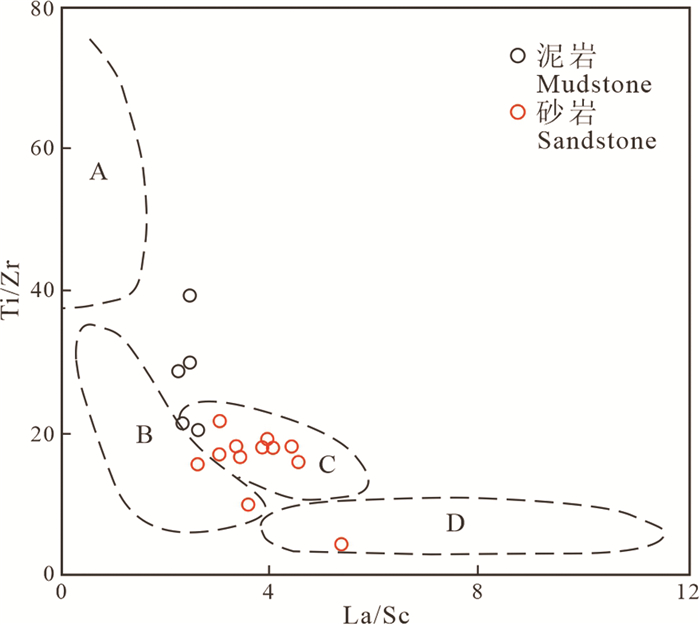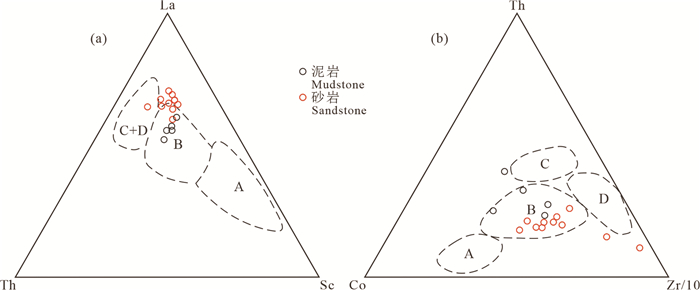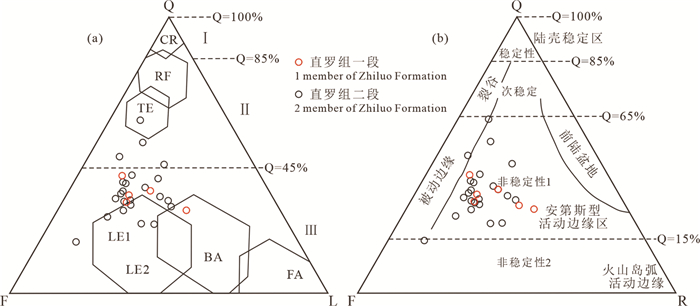Geochemical characteristics of clastic rocks from the Jurassic Zhiluo Formation in Lingwu, Ningxia and analysis of tectonic background of the source area
-
摘要:研究目的
直罗组在整个侏罗纪演化过程中处于湖进与湖退序列的转换时期,其构造背景对研究鄂尔多斯盆地西缘断褶带发育的启动时限意义重大。
研究方法本文采用XRF和ICP-MS对宁夏灵武侏罗系直罗组16件碎屑岩样品进行了主微量元素及稀土元素测试分析,旨在揭示灵武直罗组碎屑岩地球化学特征及源区构造背景。
研究结果主量元素间相关系数较低,微量元素及稀土元素自身相关系数较高,Al2O3与微量元素Co、Ni、Cr、V、Sc、Li、Cs、Be、Ga、Tl、Cu、Pb、Zn、Sn等元素之间相关系数多大于0.9,TiO2与Nb之间的相关系数为0.98,整体显示了沉积物源以陆源碎屑为主;富集集中型(K>1、CV>1)元素有Zr、U、CaO元素;富集分散型(K>1、CV<1)元素有Al2O3、Fe2O3、MgO、Sr、Ba、U、Co、V、Sc、Li、Pb;贫乏分散型(K<1、CV<1)元素有SiO2、TiO2、MnO、Na2O、K2O、P2O5、Rb、Th、Nb、Ta、Ni、Cr、Cs、Be、Ga、Tl、Cu、Zn、As、Sn及稀土元素;缺乏贫乏集中型(K<1、CV>1)元素。
结论主量元素特征氧化物组合的平均值TiO2(0.54)、TFe2O3+MgO(4.58)、Al2O3/SiO2(0.18)与活动大陆边缘相似,微量元素蛛网图显示直罗组岩石富集Rb、K、U等大离子亲石元素,强烈亏损Nb、Sr、P、Ti,稀土元素球粒陨石标准化配分曲线总体表现为轻稀土富集,重稀土相对亏损的平缓右倾模式,泥岩CIA(70.76~81.88),砂岩ICV(1.02~1.6)>泥岩ICV(0.7~1.14),泥岩ICV基本小于或等于1,指示灵武直罗组没有或经历了很弱的再旋回作用,属于构造活动背景下的初次沉积,分化程度中等。地球化学特征表明灵武直罗组源区构造背景主要与活动大陆边缘相关,与大陆岛弧也有较多联系,总体显示为活动大陆边缘或活动陆缘消减带,而且可能为安第斯型活动大陆边缘。
创新点: 利用碎屑岩地球化学特征分析了宁夏灵武地区侏罗系直罗组沉积物源特征,探讨了研究区直罗组源区沉积构造背景。
Abstract:This paper is the result of geological survey engineering.
ObjectiveThe Zhiluo Formation represents a transitional phase in the lake's advancement and retreat within the broader context of Jurassic geological evolution. Its tectonic background holds paramount importance in exploring the inception timeline of fault-fold belt development along the western margin of the Ordos Basin. This study focuses on the Zhiluo Formation, specifically clastic rocks, from the Jurassic period in the Lingwu area, Ningxia.
MethodsWe conducted analyses using X-ray and ICP-MS techniques to uncover the geochemical characteristics of clastic rocks and the structural context of the source region.
ResultsOur results reveal that major element correlation coefficients are generally low, while trace elements and REE exhibit high values. Notably, correlation coefficients between Al2O3 and trace elements such as Co, Ni, Cr, V, Sc, Li, Cs, Be, Ga, Tl, Cu, Pb, Zn, and Sn exceed 0.9, and the correlation coefficients between TiO2 and Nb are at 0.98. This suggests that the primary source of sediment is terrigenous clastic material. Enrichment concentration-type elements (K>1, CV>1) include Zr, U, and CaO, while enrichment dispersion-type elements (K>1, CV < 1) consist of Al2O3, Fe2O3, MgO, Sr, Ba, U, Co, V, Sc, Li, and Pb. Poorly dispersive elements (K < 1, CV < 1) encompass SiO2, TiO2, MnO, Na2O, K2O, P2O5, Rb, Th, Nb, Ta, Ni, Cr, Cs, Be, Ga, Tl, Cu, Zn, As, Sn, and REE. No elements fall under the poor concentration type (K < 1, CV>1).
ConclusionsThe average values for key oxide combinations of main elements are TiO2 (0.54), TFe2O3+MgO (4.58), Al2O3/SiO2 (0.58), and Al2O3/SiO2 (0.18), indicating similarity to an active continental margin. A trace element spider diagram demonstrates the rocks of the Zhiluo Formation's richness in Rb, K, and U, which are large ion lithophile elements, and a significant deficit in Nb, Sr, P, and Ti. The chondrite-standardized REE distribution curve depicts a gentle right-leaning pattern, signifying LREE enrichment and HREE relative depletion. In terms of geochemical indices, the CIA (70.76-81.88) for mudstone exceeds the ICV (1.02-1.6) for sandstone, while mudstone ICV (0.7-1.14) remains mostly less than or equal to 1. This suggests that the Zhiluo Formation in the Lingwu area exhibits little to no recycling and is characteristic of primary sedimentation in the context of tectonic activity with a moderate degree of differentiation. Correlation diagrams indicates that tectonic background of the source region is primarily associated with an active continental margin. Additionally, it exhibits some links to continental island arc systems, suggesting an active continental margin or an active continental margin subduction zone, potentially resembling an Andean-type active continental margin.
-
1. 引言
找矿模型,又称勘查模型,是表述目标矿床及其对一定勘查技术产生预期效应的模拟体系,利用已有地质信息及现有找矿手段,并通过找矿模型来实现成矿的预测。找矿模型的建立不仅需要总结地质直接找矿标志,还需要借助地球物理、地球化学等间接找矿标志识别成矿信息,推断矿体空间位置(陈毓川和朱裕生,1993)。陈毓川和朱裕生(1993)指出找矿模型突出的是某类矿床的基本要素和找矿过程中特殊意义的地质、物化探和遥感影像等特征及其在空间的变化情况,总结发展该类矿床的基本标志和找矿使用的方法手段。找矿模型是矿产勘查工作的实际指导,它是缩小勘查区(或靶区)甚至发现矿床的择优技术。当前,地质找矿已由浅部逐步转变为深部矿、隐伏矿,其找矿难度也逐步增大,对隐伏矿预测定位及找矿模型的建立显得尤为关键。
20世纪80年代以来,中国的地质工作者开始探索建立找矿模型的技术,来处理和分析各类地学资料进行综合分析,为普查和评价矿产资源提供依据,根据所利用的地学数据的不同来源,综合研究成果分别表述为矿田或矿床的地球物理模型、地球化学模型、地质-地球物理-地球化学模型或物理-地质模型。20世纪90年代以来,中国许多研究者对找矿模型的建模技术进行了系统的总结和推广。在寻找隐伏矿床的新方法上,多位研究者也建立了特有的找矿模型,如活动金属离子法、金属活动态法(MOMEO、(MMI) (Mann et al., 1998)、地气法(geogas) (Malmqvistet et al., 1984)。姚金炎(1990)提出综合物探、化探的隐伏矿床预测方法生物地球化学法、离子晕法、电吸附(周奇明,1996)、植物地球化学、地电化学等。
箭猪坡矿床作为五圩矿田矿集区代表性矿床之一,该矿床于20世纪80年代被发现,先后进行了普查和详查工作,经过20多年的开采,矿山资源量已不能满足矿山开采需求,急需开展地质找矿工作,增加储量。前人对该矿床的地质特征、矿床成因,流体特征等方面开展了较多的研究,普遍认为其受构造控制的岩浆期后热液脉状矿床。然而,箭猪坡矿床乃至五圩矿田的同类型矿床至今缺少找矿模式的研究。笔者所在项目组2012—2016年先后对箭猪坡矿床开展了构造控矿规律、矿体定位预测及外围探矿权找矿预测研究等工作,首次在五圩矿田箭猪坡矿床发现了石英脉型锡矿体,矿体呈脉状,倾角70°~75°,矿体平均品位:锡0.65%,铅0.56%、锑0.73%、银46 g/t,锡石主要呈棕褐色,多沿裂隙发育,呈条带状。经锡物相分析,锡以锡石为主。并对紧邻采矿权外围的花洞、板才探矿权开展了土壤地球化学测量、地电化学测量、瞬变电磁测量、可控源测量工作,大大丰富了找矿信息。本文在综合分析箭猪坡矿床地质、物探、化探特征基础上,构建了箭猪坡锑多金属矿地质-物探-化探测量综合信息找矿模型(经验证找矿效果良好),以期为箭猪坡锑多金属矿集区热液脉型矿床及外围同类型矿床找矿勘查和评价工作提供重要参考。
2. 矿床地质特征
五圩矿田位于丹池多金属成矿带南端(图 1)。区内出露的地层为下泥盆统塘丁组(D1t)—中三叠统(T2b);其中赋矿层位为下泥盆统塘丁组条带状绢云母泥岩夹砂岩(箭猪坡矿床),中泥盆统罗富组泥灰岩(三排洞—芙蓉厂矿床),上泥盆统榴江组、五指山组硅质岩。区域构造较为复杂,主要由五圩复式背斜及一系列以NNW向为主的张扭性断裂组成。北北西走向断裂带是五圩矿田内最发育的一组构造形迹,呈帚状构造的形态,向北北西向(箭猪坡—芙蓉厂)逐渐撒开,在花洞南东向成逐渐收敛状态,断裂带控制着区域矿化带的形成与发育。区域上未见岩浆岩出露。
![]() 图 1 五圩矿田区域地质简图T—三叠系(粉砂质泥岩、泥质粉砂岩、灰岩);P—二叠系(灰岩、凝灰岩、硅质岩);C—石炭系(条带灰岩、微晶灰岩、泥岩);D—泥盆系(泥岩、灰岩、硅质岩); 1—背斜轴;2—向斜轴;3—断裂;4—铅锌锑银矿床;5—砷汞铅锌锑银矿床;6—锑矿点;7—汞矿床(点);8—矿田Figure 1. Regional geologic map of Wuxu mining areaT-Triassic system (silty mudstone, argillaceous siltstone, limestone); P-Permian System (Limestone, Tuff, Siliceous Rock); C-Carboniferous system (banded limestone, microcrystalline limestone, mudstone); D-Devonian System (Mudstone, Limestone, Siliceous Rock); 1-Anticlinal Axis; 2-Syncline axis; 3-Fracture; 4-Pb-Zn-Sb-Ag deposit; 5-Arsenic-mercury-lead-zinc-antimony-silver deposit; 6-Antimony ore site; 7-Mercury deposit (spot); 8-Ore field
图 1 五圩矿田区域地质简图T—三叠系(粉砂质泥岩、泥质粉砂岩、灰岩);P—二叠系(灰岩、凝灰岩、硅质岩);C—石炭系(条带灰岩、微晶灰岩、泥岩);D—泥盆系(泥岩、灰岩、硅质岩); 1—背斜轴;2—向斜轴;3—断裂;4—铅锌锑银矿床;5—砷汞铅锌锑银矿床;6—锑矿点;7—汞矿床(点);8—矿田Figure 1. Regional geologic map of Wuxu mining areaT-Triassic system (silty mudstone, argillaceous siltstone, limestone); P-Permian System (Limestone, Tuff, Siliceous Rock); C-Carboniferous system (banded limestone, microcrystalline limestone, mudstone); D-Devonian System (Mudstone, Limestone, Siliceous Rock); 1-Anticlinal Axis; 2-Syncline axis; 3-Fracture; 4-Pb-Zn-Sb-Ag deposit; 5-Arsenic-mercury-lead-zinc-antimony-silver deposit; 6-Antimony ore site; 7-Mercury deposit (spot); 8-Ore field箭猪坡矿床范围内出露的地层为下泥盆统塘丁组第一段和第二段,其中以第二段为主,该段为灰黑色条带状及薄层状绢云母泥岩;矿床内发育了两组断裂,一组为北北西向张扭性断裂,第二组为北北东向扭性断裂。在矿区范围内未见到岩浆岩出露。
箭猪坡矿床矿体主要受北北西向构造破碎带和断裂的控制,呈脉状、细网脉状,条带状充填在断裂带中或节理裂隙中,沿矿体走向和倾向分支复合、尖灭再现和尖灭侧现的现象均有出现。矿石中金属矿物主要有硫化物(铁闪锌矿、闪锌矿、辉锑矿)、硫盐矿物(脆硫锑铅矿等),碳酸盐矿物(含锰菱铁矿、含铁菱锰矿),非金属矿物主要有石英、方解石等(刘伟,2013)。箭猪坡矿床成矿阶段划分为3个阶段,即石英-硫化物阶段(Ⅰ)、石英-硫盐矿物-多硫化物阶段(Ⅱ)和锑硫化物-石英-铁锰碳酸盐阶段(Ⅲ),第Ⅱ成矿阶段为主要成矿阶段(刘伟等,2015)。
3. 地球物理特征
本次研究工作选用的物探工作方法有瞬变电磁测量(TEM)、可控源音频大地电磁测深法(CSAMT)。物探测线布置图见图 2。
![]() 图 2 箭猪坡矿床物化探工作测线分布图1—三叠系百逢组中段(细砂岩、泥质粉砂岩); 2—三叠系百逢组下段(含粉砂质泥岩夹凝灰质泥岩); 3—中三叠统罗楼祖上段(粉砂质泥岩夹灰岩); 4—中三叠统罗楼组下段(粉砂质泥岩); 5—下二叠统茅口组(燧石条带灰岩); 6—下二叠统栖霞组(灰岩、泥灰岩、硅质岩); 7—上石炭统南丹组(硅质条带灰岩、微晶灰岩)8—中石炭统大埔组(白云岩、含生物硅质条带灰岩); 9—下石炭统巴平组(泥岩、硅质泥岩); 10—上泥盆统五指山组(灰岩); 11—上泥盆统榴江组(硅质岩、硅质灰岩、灰岩); 12—中泥盆统罗富组上段(泥质灰岩、生物碎屑灰岩); 13—中泥盆统罗富组中段(泥灰岩夹泥岩); 14—中泥盆统罗富组下段(钙质泥岩、泥灰岩); 15—下泥盆统塘丁组四段(泥岩); 16—下泥盆统塘丁组三段(泥岩、粉砂质泥岩); 17—下泥盆统塘丁组二段(泥岩夹砂质泥岩); 18—下泥盆统塘丁组一段(泥岩); 19—实测正断层; 20—实测逆断层; 21—岩层产状; 22—地质界线; 23—大型锑多金属; 24—工作区范围; 25—可控源测量测线及编号; 26—瞬变电磁测量、地电化学测量、土壤地球化学测量测线Figure 2. Distribution of geophysical and chemical detection lines in Jianzhupo Deposit1-Middle of Triassic Baifeng Formation (fine sandstone and argillaceous siltstone); 2-Lower of Triassic Baifeng Formation (silty mudstone mixed with tuffaceous mudstone); 3-Upper of Middle Triassic Luolouzu Formation (silty mudstone mixed with limestone); 4-Lower of Middle Triassic Luolou Formation (silty mudstone); 5-Lower Permian Maokou Formation (flint banded limestone); 6-Lower Permian Qixia Formation (limestone, marl, siliceous rock); 7-Upper Carboniferous Nandan Formation (siliceous banded limestone) Microcrystalline limestone); 8-Middle Carboniferous Dapu Formation (dolomite, siliceous banded limestone); 9-Lower Carboniferous Baping Formation (mudstone, siliceous mudstone); 10-Upper Devonian Wuzhishan Formation (limestone); 11-Upper Devonian Liujiang Formation (siliceous rock, siliceous limestone, limestone); 12-Middle Devonian Luofu Formation upper member (argillaceous limestone, Bioclastic limestone); 13-Middle of Middle Devonian Luofu Formation (marl with mudstone); 14-Lower Devonian Luofu Formation (calcareous mudstone and marl); 15-Lower Devonian Tangding Formation 4 (mudstone); 16-Lower Devonian Tangding Formation 3 (mudstone, Silty mudstone); 17-Member 2 of Lower Devonian Tangding Formation (mudstone mixed with sandy mudstone); 18-Member 1 of Lower Devonian Tangding Formation (mudstone); 19-Measured normal fault; 20-Measured reverse fault; 21-Strata occurrence; 22-Geological boundary; 23-Large antimony polymetallic; 24-Scope of work area; 25-Controlled source measuring line and No; 26-Transient electromagnetic measuring line, geoelectrochemical measuring line and soil geochemical measuring line
图 2 箭猪坡矿床物化探工作测线分布图1—三叠系百逢组中段(细砂岩、泥质粉砂岩); 2—三叠系百逢组下段(含粉砂质泥岩夹凝灰质泥岩); 3—中三叠统罗楼祖上段(粉砂质泥岩夹灰岩); 4—中三叠统罗楼组下段(粉砂质泥岩); 5—下二叠统茅口组(燧石条带灰岩); 6—下二叠统栖霞组(灰岩、泥灰岩、硅质岩); 7—上石炭统南丹组(硅质条带灰岩、微晶灰岩)8—中石炭统大埔组(白云岩、含生物硅质条带灰岩); 9—下石炭统巴平组(泥岩、硅质泥岩); 10—上泥盆统五指山组(灰岩); 11—上泥盆统榴江组(硅质岩、硅质灰岩、灰岩); 12—中泥盆统罗富组上段(泥质灰岩、生物碎屑灰岩); 13—中泥盆统罗富组中段(泥灰岩夹泥岩); 14—中泥盆统罗富组下段(钙质泥岩、泥灰岩); 15—下泥盆统塘丁组四段(泥岩); 16—下泥盆统塘丁组三段(泥岩、粉砂质泥岩); 17—下泥盆统塘丁组二段(泥岩夹砂质泥岩); 18—下泥盆统塘丁组一段(泥岩); 19—实测正断层; 20—实测逆断层; 21—岩层产状; 22—地质界线; 23—大型锑多金属; 24—工作区范围; 25—可控源测量测线及编号; 26—瞬变电磁测量、地电化学测量、土壤地球化学测量测线Figure 2. Distribution of geophysical and chemical detection lines in Jianzhupo Deposit1-Middle of Triassic Baifeng Formation (fine sandstone and argillaceous siltstone); 2-Lower of Triassic Baifeng Formation (silty mudstone mixed with tuffaceous mudstone); 3-Upper of Middle Triassic Luolouzu Formation (silty mudstone mixed with limestone); 4-Lower of Middle Triassic Luolou Formation (silty mudstone); 5-Lower Permian Maokou Formation (flint banded limestone); 6-Lower Permian Qixia Formation (limestone, marl, siliceous rock); 7-Upper Carboniferous Nandan Formation (siliceous banded limestone) Microcrystalline limestone); 8-Middle Carboniferous Dapu Formation (dolomite, siliceous banded limestone); 9-Lower Carboniferous Baping Formation (mudstone, siliceous mudstone); 10-Upper Devonian Wuzhishan Formation (limestone); 11-Upper Devonian Liujiang Formation (siliceous rock, siliceous limestone, limestone); 12-Middle Devonian Luofu Formation upper member (argillaceous limestone, Bioclastic limestone); 13-Middle of Middle Devonian Luofu Formation (marl with mudstone); 14-Lower Devonian Luofu Formation (calcareous mudstone and marl); 15-Lower Devonian Tangding Formation 4 (mudstone); 16-Lower Devonian Tangding Formation 3 (mudstone, Silty mudstone); 17-Member 2 of Lower Devonian Tangding Formation (mudstone mixed with sandy mudstone); 18-Member 1 of Lower Devonian Tangding Formation (mudstone); 19-Measured normal fault; 20-Measured reverse fault; 21-Strata occurrence; 22-Geological boundary; 23-Large antimony polymetallic; 24-Scope of work area; 25-Controlled source measuring line and No; 26-Transient electromagnetic measuring line, geoelectrochemical measuring line and soil geochemical measuring line可控源音频大地电磁法(CSAMT)是在大地电磁法(MT)和音频大地电磁法(AMT)基础上发展起来的一种方法。可控源频率测深方法具有勘探深度范围大(通常可达2 km)、分辨能力强、观测效率高,兼有测深和剖面研究双重特点,是研究深部地质构造和寻找隐伏矿的有效手段,越来越多应用于受构造控制的脉状金属矿床的找矿工作。通过可控源音频大地电磁测深法(CSAMT)测量,探索箭猪坡矿床深部隐伏构造的空间形态。
磁瞬变电磁法(TEM)是基于电性差异,利用不接地回线或接地线源向地下发送一次脉冲电场,利用线圈或接地电极观测二次涡流场或电场的方法。该方法具有穿透低阻覆盖的能力,故探测深度大。在低阻围岩地区地形的起伏仅对早期道有影响,这种影响又是易于分辨的。瞬变电磁法异常响应强,多测道曲线形态简单,分层能力较强。工作效率高,同时完成剖面测量与测深工作。通过瞬变电磁测量(TEM),查明构造和矿(化)体空间展布特征。
3.1 矿区岩(矿)石物性特征
在物探方法工作前,先对矿区内的主要岩矿石进行物性参数取样分析。矿区内出露的主要矿石划分为5类,围岩划分为7类。每类岩(矿)石进行系统的物性参数取样。所采集标本均来自新鲜露头及坑道,大小约10 cm×10 cm×10 cm,使用测试方式为强迫电流法,获得岩矿石标本的电阻率参数,使用GDD型标本测试仪,测定结果如表 1所示。根据表 1,矿区内与低阻因素有关的是断裂破碎带、矿化蚀变及炭质岩层,因此,圈定低阻异常区是本次电法工作的重点。
表 1 五圩铅锌锑矿岩石的物性特征Table 1. Physical properties of Wuxu Pb-Zn-Sb ore and rocks
(1)密度特征
区域出露的地层从下泥盆统塘丁组至中三叠统均有,是高密度层,以泥岩、碳酸盐岩为主,其岩性主要有泥岩、白云质泥灰岩、泥质粉砂岩、炭质泥岩、硅质泥岩、泥灰岩、白云岩、硅质岩、硅质灰岩、生物碎屑灰岩等,以上岩性密度值相对较高且较为稳定,一般为2.71 g/cm3左右。
根据实测及前人的资料,五圩矿区的各类岩石中,以松散的砂岩、砾岩等密度最低,一般为2.48 g/cm3,这些岩层的厚度不大;泥岩、碳酸盐岩建造为主的岩层,其厚度可达数千米,密度平均值为2.71 g/cm3,构成高密度背景;花岗岩类岩石密度平均值为2.61 g/cm3,与泥岩、碳酸盐岩为围岩的密度存在0.1 g/cm3左右的差异,当花岗岩体具有一定规模时,可以引起重力低异常。
(2)电性特征
矿床中岩石在宏观上电阻率ρ与电极化率η呈负相关,即η增大,ρ有减小的趋势。矿床中的炭质泥岩、钙质泥岩具有“低电阻率”特征,电阻率常见为5.2×101~5.1×102 Ω·m,最大为3.9×103 Ω·m,而矿床中方解石、白云岩、硅质泥岩、灰岩具有“高电阻率”特征,电阻率常见为4.1×103~7.3×105 Ω·m,最大为9.8×105 Ω·m。含矿岩石具有低电阻、高极化率、高密度特征。矿床围岩普遍具有中高电阻率、低极化率、中等密度特征。矿区内炭质泥岩普遍发育,其具有低电阻率、高极化率特征,且具有成层出现的特点,其矿石与围岩存在较明显的电性差异,为电磁法测量工作提供了有利条件。
(3)磁性特征
工作区内绝大部分岩石为无磁性或弱磁性,花岗岩呈弱磁性,一些矿石含有少量磁性矿物磁性相对较强,但仍呈弱磁性。
3.2 可控源(CSAMT)特征
结合矿床地质特征,笔者在五圩箭猪坡矿床开展了可控源剖面测量工作(位置见图 2),试验剖面有3条,测量方位线与勘探线方位一致为80°,点距40 m。投入本次工作的仪器为GDP-32II多功能电磁仪。工作选择的是GGT-30大功率(30 kAV)发射机,工作频率:DC~8 kHz;最大输出功率:30 kW;最大输出电流:30 A;最高输出电压:1000 V;关断时间:≤125 μs;稳流精度:0.1%;同时配合工作的是一个ZMG-10(10 kW)发电机。CSAMT资料反演软件是GDP-32II机器所带的带地形平面波反演软件SCS2D。
本次CSAMT工作各技术参数如下:工作频率:1~8192 Hz。发射系统:供电偶极子长度AB=1000 m;方位角117°,偶极子中心与测线中心偏差<15°。收发距R最小为7 km,最大为12.7 km;基本电流大于6 A,1024 Hz以下频率电流大于8 A。供电线使用耐高压、大电流的电缆线,供电极则将大张铝箔置于挖好的坑中埋好,并将盐水浇于其中。接收系统:采用一个磁道带两个电道测量方式。测量电偶极子长度MN=40 m。接收电极使用不极化电极,稳固地置于土中20~30 cm,并浇入盐水。观测数据叠加次数为32~16384次,数据离差SEM < 20时,方可认定为可靠数据,并将其记录。
由图 3(317线CSAMT测深)可以看出,物探CSAMT测深曲线圆滑,其卡尼亚电阻率均方相对误差为5.783%;大于200 mrad的阻抗相位均方相对误差为8.698%,小于200 mrad的阻抗相位均方误差为40.997 mrad,测量结果为Ⅰ级精度。根据测区岩石电性特征,矿区内与低阻因素有关的是断裂破碎带、矿化蚀变及炭质岩层,由此圈定低阻异常区是本次电法工作的重点。根据电阻率剖面结果,反演的低阻异常,对应的阻抗相位高值异常,因此低阻异常可信度高。
以317号勘探线剖面图为例(图 4)。选取该线的3160~4520点号,作为反演剖面,长度1.36 km,317线低阻异常及推断解释见图 4,其特征如下:3840~4080号点范围存在⑤号低阻异常,电阻率低于100 Ω·m,呈带状分布,异常上窄下宽,向东倾斜,延深约1200 m,⑤号低阻异常位于下泥盆统塘丁组第二岩性段(D1t2),主要为灰—深灰色中薄层泥岩夹深灰色中薄层条带状泥岩,局部夹有薄层砂岩透镜体和砂质泥岩,岩石中普遍见有浸染状黄铁矿,该岩性段为矿区主要含矿层位。已知含矿破碎带F3及F7位于⑤号低阻异常边部或异常内,且有钻孔ZK317-1揭露,其破碎带产状与⑤号低阻异常形态一致,推测⑤号低阻异常是由含矿破碎带F3和F7引起。目前钻孔只揭露了含矿破碎带F3及F7浅部垂深200 m范围的情况,从电阻率剖面图看出,⑤号低阻异常往深部延深至标高-700 m,说明含矿破碎带F3及F7往深部仍有延伸,该异常深部仍具有较大的找矿空间。
![]() 图 4 箭猪坡矿床317号勘探线电阻率剖面与推断解释剖面图1—泥盆系下统塘丁组第三段;2—泥盆系下统塘丁组第二段;3—断裂;4—钻孔;5—电阻率异常带Figure 4. Resistivity profile and inferred interpretation profile of 317 geological profile in Jianzhupo Deposit1-Third Member of Tangding Formation of Lower Devonian system; 2-Second Member of Tangding Formation of Lower Devonian system; 3-Fault; 4-Drill holel; 5-Resisttivity anomaly band
图 4 箭猪坡矿床317号勘探线电阻率剖面与推断解释剖面图1—泥盆系下统塘丁组第三段;2—泥盆系下统塘丁组第二段;3—断裂;4—钻孔;5—电阻率异常带Figure 4. Resistivity profile and inferred interpretation profile of 317 geological profile in Jianzhupo Deposit1-Third Member of Tangding Formation of Lower Devonian system; 2-Second Member of Tangding Formation of Lower Devonian system; 3-Fault; 4-Drill holel; 5-Resisttivity anomaly band从以上结果看出,CSAMT法探测深度大,对断裂构造反应较灵敏,在五圩矿田可以取得较好的找矿效果。
3.3 瞬变电磁特征
本次TEM法采用重叠回线装置(接收线圈Rx和发送线圈Tx相重合敷设的装置),发射和接收线圈均为100 m×100 m,网度为100 m×50 m;通过试验应采用1 Hz和4 Hz作为发射基频,观测参数为归一化的感应电动势,单位为μV/A。本次使用仪器为重庆奔腾数控技术研究所研制的WTEM-1瞬变电磁仪。以箭猪坡矿床320号勘探线剖面为例(测线分布见图 2),运用一维电阻率反演(图 5),结合地质特征分析得出:通过320线多测道剖面图可见,在23~34点之间存在凸起异常,与相对低阻异常吻合较好,从形态上看,呈脉状,表明在中深部存在导电性较好的脉状地质体,反映了中深部硫化物矿(化)体的存在。从电阻率反演图中可以得出,标高200~300 m,异常带晕为一个呈现倾向东的低阻带,电阻率值一般小于100 Ω·m,多为0~50 Ω·m,倾角为50~60°,与高阻区域区别明显,且该异常带由近地表往深部有变宽的趋势。该地段构造发育,结合矿区岩矿石物性特征及矿区的地质特征推测为含金属硫化物的岩(矿)石引起的异常。通过在地表实施探槽及钻孔(ZK320-2、ZK320-3、ZK320-4、ZK320-5)验证,均揭露到含黄铁矿化的硅化破碎带或矿(化)体,已知硅化破碎带或矿(化)体,均分布在电阻率低阻区。
4. 地球化学特征
4.1 土壤地球化学特征
在箭猪坡矿区开展了土壤剖面地球化学测量工作,以箭猪坡矿床320号勘探线剖面为例,结果显示矿区土壤地球化学化学主成矿元素Pb、Zn、Sb异常与隐伏矿体(含矿破碎带)的分布范围相一致,各异常同步性较好,并且有很好的重叠性。Pb最高值为97.4×10-6,异常带Pb均值大于65×10-6;Zn最高值为255.9×10-6,异常带均值大于220×10-6;Sb最高值为154.8×10-6,异常带均值大于90×10-6;推测异常由破碎带(含矿)引起,并经钻探工作验证,在钻孔中见到真厚0.71m,Zn品位5.05%的锌矿体(钻孔ZK320-2、J144)。
4.2 地电化学特征
地电化学提取方法是将地球物理、地球化学及电化学综合交叉为一体的综合找矿方法,该方法利用电场作用,选择性提取近地表介质中的电活动态物质,通过研究电提取元素组合、含量分布及异常特征,进而提供找矿信息的一种勘查方法。而大量的找矿勘探实践证明,地电化学勘探新技术、新方法能够发现500 m以下,其中包括150~200 m浮土以下的有色金属矿床、贵金属矿床、稀有金属矿床。在箭猪坡矿床南端开展了6条地电化学剖面测量工作(测线分布见图 2),方位线与勘探线方位一致为80°,点距一般20 m,以320号勘探线剖面地电化学特征为例(图 5):地电化学异常与隐伏矿体或含矿破碎带的分布吻合度高,即矿体的分布范围与地电化学综合异常范围一致,异常分布的规模、强度与含矿破碎带规模呈正比关系。矿体产出均较陡,倾角75°~80°,异常为多个异常点组成的“驼峰”或者“倒钟”形态,在地表矿头对应部位附近有异常峰。Pb、Zn、Sb元素异常规模大、强度高,异常同步清晰,因此Pb、Zn、Sb可以作为本区地电化学方法寻找隐伏锌矿的指示元素。当出现Pb、Zn、Sb为主异常时,则显示深部具有隐伏矿体(矿化)存在的可能性。经钻探验证,ZK320-2、ZK320-4、ZK320-5钻孔均揭露到了含锌锑的矿体及富含黄铁矿的硅化破碎带,亦说明地电化学能很好的圈定金属硫化物异常。
![]() 图 5 箭猪坡矿床320号勘探线地质-物探(TEM)-化探(地电化学)综合剖面图1—构造破碎带;2—铅锌锑矿体;3—下泥盆统塘丁组第二段;4—钻孔Figure 5. Electrogeochemical comprehensive profile of 320 exploration line in Jianzhupo Deposit1-Tectonic fracture zone; 2-Lead-zinc-antimony ore body; 3-Second member of Tangding Formation of Lower Devonian system; 4-Drill hole
图 5 箭猪坡矿床320号勘探线地质-物探(TEM)-化探(地电化学)综合剖面图1—构造破碎带;2—铅锌锑矿体;3—下泥盆统塘丁组第二段;4—钻孔Figure 5. Electrogeochemical comprehensive profile of 320 exploration line in Jianzhupo Deposit1-Tectonic fracture zone; 2-Lead-zinc-antimony ore body; 3-Second member of Tangding Formation of Lower Devonian system; 4-Drill hole5. 综合找矿模型特征
根据箭猪坡矿床地质特征、地球物理特征、地球化学特征,总结了该矿床地质、地球物理,地球化学的找矿标志(表 2),并建立了矿床的地质-化探-物探找矿模型(图 6),实质是反映化探特征、物理特征与地质构造、矿体的空间关系。
表 2 箭猪坡矿床地质-地球物理-地球化学找矿标志Table 2. Geological-geophysical -geochemical prospecting criteria of JianZhuPo Deposit
从矿床成矿条件分析,箭猪坡矿床矿体赋存在断裂构造中,矿体形态呈脉状、透镜体状,空间分布具有斜列状,叠瓦状排列等。区内矿体具有明显的低阻异常,表现为低电阻率特征,且瞬变电磁反演断面图与硅化破碎带及地质内容吻合较好。
模型的地质特征:矿体受层位控制,控矿层位为下泥盆统塘丁组沉积建造,因构造变形,控矿层位位于褶皱翼部,产状一般较陡;近矿围岩蚀变发育范围有限,蚀变类型有硅化、黄铁矿化、绢云母化、绿泥石化等。矿体形态以陡产状脉状、细脉状、透镜状为主,倾角60°~80°,厚度0.1~4.5 m不等,最大10.72 m,矿石类型分致密块状和条带状;矿石以金属硫化物为主,并含硫盐矿物;矿床类型属低温热液充填型。
模型的地球物理特征:以工业矿体为中心的矿化系统,具有低电阻率,稍高密度,高极化率特征。
模型的地球化学特征:常规土壤异常较小或无异常,而地电化学异常能较清晰地反映盲矿体成矿元素的异常,且各元素间连续性较好,异常的分布范围与深部盲矿体的垂直投影基本一致,通过钻孔揭露,能较准确的反映深部埋藏盲矿体(矿化体)的分布范围。
6. 讨论
(1)通过近几年的找矿勘查,在箭猪坡矿床,矿带走向延伸控制总长度为1400 m,并根据物探可控源测量结果,经钻探工程控制,在标高为-300~-400 m)仍能见到矿体, 从而扩大了该区的找矿空间,在该矿带南、北两个延伸方向及东部矿体倾向延深方向都是寻找隐伏矿体的有利部位,勘查平面图、剖面图等资料表明矿体的倾向延深和南北走向延伸还未完全控制,尚有较大找矿空间。而且随着深部石英脉型锡矿体的发现,为该矿区增加了新的找矿方向。
(2)矿区中局部构造陡倾或直立,且构造中有炭质、硅质等围岩,具有极低或极高的电阻率,故引起了CSAMT测量反演结果出现电阻率非常大和非常小的值。
(3)受整个区围岩炭质泥岩背景影响,该区矿化不均匀,极化率值波动较大,矿区未采样激发极化法, 其还难以识别矿异常和非矿异常。
因此,对于箭猪坡矿床成因需要加强研究,勘查模型需要逐步完善,找矿方法手段的选择也需要不断探索。
7. 结论
物化探工作是目前找矿工作中的重要手段。在充分分析、深入研究物化探成果特征,选出与成矿有关的异常范围,尤其是物化探重叠异常范围,再以地质条件为基础,化探信息为先导,选取地质、化探、物探等成矿有关的综合信息标志重叠的地区或地段,是寻找成矿有利地段的保障。
(1)物探研究表明:CSAMT出现的所有低阻异常,均具有找矿意义。这类低阻异常范围、形态大致反映矿(化)脉组在空间的展布特征,为深部勘查工程布置提供了重要依据;CSAMT异常显示该区往南北两端仍具有较大的找矿空间,中深部层状低阻异常出现在较低标高,均具有较大规模,且没有完全控制,这类异常推测与炭质层或新类型矿化有关。瞬变电磁表明:矿(化)体多分布在归一化电位高值区或低电阻率区,已知构造主要分布在归一化电位较高值区域或较低电阻率区和电位值梯度带,已知矿化体与物探异常特征吻合较好。
(2)常规的化探次生晕及地电化学研究表明:地电化学异常在已知矿体上方有比较清晰的Pb、Zn、Sb元素异常,为典型的共生组合元素,它们之间也存在良好的正相关关系,说明这些元素组合可以作为找矿指示元素,在该地区利用地电化学在该地区寻找隐伏矿,方法是可行的。化探次生晕Sb、Pb、Zn等元素套和较好,异常特征相近,可以作为寻找本区矿区的主要指示元素,进而推断矿体存在的大致位置和特征。
综上所述,可控源音频大地电磁法、瞬变电磁法、土壤地球化学、地电化学在异常区和非异常区有效性明显,利用这四种集成方法对深部勘查预测具有良好的找矿效果,达到技术集成示范,值得在类似的矿床中应用。
致谢: 感谢四川省地质矿产勘查开发局区域地质调查队游水生高级工程师、李振江高级工程师在野外地质调查及论文编写过程中给予的大力支持与帮助。 -
图 1 鄂尔多斯盆地西缘构造纲要图(据曹代勇等,2015修编)
1—逆断层/正断层;2—平移断层;3—省界;4—河流;5—研究区;6—构造分区;Ⅰ—六盘山东麓逆冲推覆构造系统;Ⅱ—贺兰山逆冲推覆构造系统;①—磴口—阿拉善左旗断裂;②—小松山断裂;③—卓子山东麓断裂;④—贺兰山东麓断裂;⑤—黄河断裂;⑥—青铜峡—固原断裂;⑦—韦州—安国断裂;⑧—青龙山—平凉断裂;⑨—惠安堡—沙井子断裂;⑩—马柳断裂;⑪—车道—阿色浪断裂;⑫—正义关断裂
Figure 1. Structural outline map of the western margin of Ordns Basin (modified from Cao Daiyong et al., 2015)
1-Reverse fault/Normal fault; 2-Translation fault; 3-Provincial boundary; 4-River; 5-Study area; 6-Structural division; I-Thrust nappe structural system at the eastern foot of Liupan Mountain; II-Helan Mountain thrust nappe structural system; ①-Dengkou-Alashan Zuoqi fault; ②-Xiaosongshan fault; ③-Fault at the eastern foot of Zhuozi Mountain; ④-Fault at the eastern foot of Helan Mountain; ⑤-Yellow River fault; ⑥-Qingtongxia-Guyuan fault; ⑦-Weizhou Anguo fault; ⑧-Qinglongshan-Pingliang fault; ⑨-Huianpu-Shajingzi fault; ⑩-Maliu fault; ⑪-Chedao-Aselang fault; ⑫-Zhengyiguan fault
图 2 研究区构造位置图(a)与地质简图(b)
1—全新统人工堆积;2—全新统冲洪积;3—全新统风成沙;4—更新统冲洪积;5—上侏罗统安定组;6—中侏罗统直罗组;7—中侏罗统延安组;8—上三叠统上田组;9—中三叠统二马营组
Figure 2. Tectonic map (a) and simplifield geological map (b) in the study area
1-Holocene artificial accumulation; 2-Holocene alluvial proluvial; 3-Holocene eolian sand; 4-Pleistocene alluvial proluvial; 5-Upper Jurassic Anding Formation; 6-Middle Jurassic Zhiluo Formation; 7-Middle Jurassic Yan'an Formation; 8-Upper Triassic Shangtian Formation; 9-Middle Triassic Ermaying Formation
图 3 灵武直罗组泥岩(a)和砂岩(b)微量元素原始地幔标准化蛛网图(标准化值据Sun and McDonough, 1989)
Figure 3. Primitive mantle-normalized spider diagrams of the mudstone (a) and sandstone (b) from Zhiluo Formation in Lingwu (normalized values are from Sun and McDonough, 1989)
图 4 灵武直罗组砂岩、泥岩稀土元素球粒陨石标准化配分图(a、c)与北美页岩标准化配分模式图(b、d)(球粒陨石标准化值据Sun and McDonough, 1989;北美页岩标准化值据Gromet et al., 1984)
Figure 4. Chondrite-normalized rare earth elements patterns (a, c) and NASC (North American shale composite)-nomalized rare earth elements patterns (b, d) of the sandstone and mudstone from Zhiluo Formation in Lingwu (Chondrite-normalized values are from Sun and McDonough, 1989; NASC-nomalized values are from Gromet et al., 1984)
图 8 灵武直罗组样品SiO2-K2O/Na2O构造环境判别图(据Roser and Korsch, 1986)
PM-被动大陆边缘;ACM-活动大陆边缘;ARC-大洋岛弧
Figure 8. Tectonic setting discrimination diagram of SiO2-K2O/Na2O from the samples of Zhiluo Formation in Lingwu (after Roser and Korsch, 1986)
PM-Passive continental margin; ACM-Active continental margin; ARC-Oceanic island arc
图 9 灵武直罗组样品(TFe2O3+MgO)-TiO2(a)和(TFe2O3+MgO)-Al2O3/SiO2(b)构造环境判别图(据Bhatia, 1983)
A—大洋岛弧;B—大陆岛弧;C—活动大陆边缘;D—被动大陆边缘
Figure 9. Tectonic setting discrimination diagrams of (TFe2O3+MgO)-TiO2 (a) and (TFe2O3+MgO)-Al2O3/SiO2 (b) of the samples from Zhiluo Formation in Lingwu (after Bhatia, 1983)
A-Oceanic island arc; B-Continental island arc; C-Active continental margin; D-Passive continental margin
图 10 灵武直罗组样品Ti/Zr-La/Sc构造环境判别图(据Bhatia and Crook, 1986)
A—大洋岛弧;B—大陆岛弧;C—活动大陆边缘;D—被动大陆边缘
Figure 10. Tectonic setting discrimination diagram of La/Sc-Ti/Zr of the samples from Zhiluo Formation in Lingwu (after Bhatia and Crook, 1986)
A-Oceanic island arc; B-Continental island arc; C-Active continental margin; D-Passive continental margin
图 11 灵武直罗组样品La-Th-Sc(a)和Th-Co-Zr/10(b)构造环境判别图(据Bhatia and Crook, 1986)
A—大洋岛弧;B—大陆岛弧;C—活动大陆边缘;D—被动大陆边缘
Figure 11. Tectonic setting discrimination diagram of La-Th-Sc (a) and Th-Co-Zr/10 (b) of the samples from Zhiluo Formation in Lingwu (after Bhatia and Crook, 1986)
A-Oceanic island arc; B-Continental island arc; C-Active continental margin; D-Passive continental margi
图 12 灵武直罗组样品QFL与QFR图解(a,据Valloni and Maynard, 1981;b,据Crook, 1974)
Q—单晶石英;F—单晶长石;L—不稳定岩屑;R—岩屑(包括多晶石英碎屑);CR—稳定克拉通内浅海盆地型;RF—裂谷及断陷盆地型;TE—被动边缘型;LE1—活动陆缘消减带型;LE2—活动边缘转换断层型;BA—弧后盆地型;FA—弧前盆地型
Figure 12. QFL and QFR diagrams of the samples from Zhiluo Formation in Lingwu (a, after Valloni and Maynard, 1981; b, after Crook, 1974)
Q-Single crystal quartz; F-Single crystal feldspar; L-Unstable debris; R-Debris (including polycrystalline quartz debris); CR-Stable intracratonic shallow basin type; RF-Rift and fault basin type; TE-Passive margin type; LE1-Active continental margin subduction zone type; LE2-Active margin transform fault type; BA-Back-arc basin type; FA-Fore-arc basin type
表 1 灵武直罗组沉积物主量元素含量分析结果(%)
Table 1 Analytical result (%) of major elements in sediments of Zhiluo Formation in Lingwu

表 2 灵武直罗组沉积物微量元素含量分析结果(10-6)
Table 2 Analytical result (10-6) of trace elements in sediments of Zhiluo Formation in Lingwu

表 3 灵武直罗组沉积物稀土元素含量分析结果(10-6)
Table 3 Analytical result (10-6) of rare earth element in sediments of Zhiluo Formation in Lingwu

表 4 灵武直罗组沉积物主量、微量、稀土元素相关性分析结果
Table 4 Characteristic element parameters of major, trace and REEs in sediments of Zhiluo Formation in Lingwu

表 5 灵武直罗组沉积物稀土元素相关性分析结果
Table 5 Correlation analysis results of REEs in sediments of Zhiluo Formation, Lingwu

表 6 灵武直罗组沉积物各元素特征参数统计
Table 6 Statistics of characteristic parameters of elements in sediments of Zhiluo Formation in Lingwu

表 7 灵武直罗组砂岩与不同构造背景砂岩主量元素特征数值比较
Table 7 Comparison of major element characteristics between sandstone of Zhiluo Formation in Lingwu and sandstone of different structural backgrounds

表 8 不同构造背景稀土元素特征值
Table 8 REE value of different tectonic settings

-
Absar N, Raza M, Roy M, Naqvi S M, Roy A K. 2009. Composition and weathering conditions of Paleoproterozoic upper crust of Bundelkhand craton, Central India: Records from geochemistry of clastic sediments of 1.9 Ga Gwalior Group[J]. Precambrian Research, 168(3/4): 313-329.
Bai Daoyuan, Zhou Liang, Wang Xianhui, Zhang Xiaoyang, Ma Tieqiu. 2007. Geochemistry of Nanhua-Cambrian sandstones in southeastern Hunan, and its constraints on Neoproterozoic-Early Paleozoic tectonic setting of South China[J]. Acta Geologica Sinica, 81(6): 755-771 (in Chinese with English abstract). http://www.researchgate.net/publication/282174899_Geochemistry_of_Nanhuan_-_Cambrian_sandstones_in_southeastern_Hunan_and_its_constraints_on_Neoproterozoic_-_Early_Paleozoic_tectonic_setting_of_south_China
Bhatia M R. 1983. Plate tectonics and geochemical composition of sandstones[J]. The Journal of Geology, 91(6): 611-627. doi: 10.1086/628815
Bhatia M R. 1985. Rare earth element geochemistry of Australian Paleozoic graywackes and mudrocks: Province and tectonic control[J]. Sedimentary Geology, 45: 97-113. doi: 10.1016/0037-0738(85)90025-9
Bhatia M R, Crook K A. 1986. Trace element characteristics of graywackes and tectonic setting discrimination of sedimentary basins[J]. Contributions to Mineralogy and Petrology, 92(2): 181-193. doi: 10.1007/BF00375292
Cao Daiyong, Xu Hao, Liu Kang, Wei Yingchun, Zhang Wenfeng, Wang Xinguo. 2015. Coalfield tectonic evolution and its controlling factors at the western margin of Ordos Basin[J]. Chinese Journal of Geology, 50(2): 410-427 (in Chinese with English abstract).
Chen Yin, Feng Xiaoxi, Chen Lulu, Jin Ruoshi, Miao Peisen, Sima Xianzhang, Miao Aisheng, Tang Chao, Wang Gui, Liu Zhongren. 2017. An analysis of U-Pb dating of detrital zircons and modes of occurrence of uranium minerals in the Zhiluo Formation of northeastern Ordos Basin and their indication to uranium sources[J]. Geology in China, 44(6): 1190-1206 (in Chinese with English abstract).
Condie K C. 1993. Chemical composition and evolution of the upper continental crust: Contrasting results from surface samples and shales[J]. Chemical Geology, 104(1/4): 1-37.
Cox R, Lowe D R, Cullers R L. 1995. The influence of sediment recycling and basement composition on evolution of mudrock chemistry in the southwestern United States[J]. Geochimica et Cosmochimica Acta, 59(14): 2919-2940. doi: 10.1016/0016-7037(95)00185-9
Crook K A W. 1974. Lithogenesis and geotectonics: The significance of compositional variation in flysch arenites (graywackes)[C]//Sepm Society for Sedimentary Geology: Tulsa, OK, USA, 304-310.
Cullers R L, Basu A, Suttner L J. 1988. Geochemical signature of provenance in sand-size mineral in soil and stream near the tobacco root batholiths, Montana, USA[J]. Chemical Geology, 70: 335-348. doi: 10.1016/0009-2541(88)90123-4
Fedo C M, Nesbitt H W, Young G M. 1995. Unraveling the effects of potassium metasomatism in sedimentary rocks and paleosols, with implications for paleoweathering conditions and provenance[J]. Geology, 23(10): 921-924. doi: 10.1130/0091-7613(1995)023<0921:UTEOPM>2.3.CO;2
Floyd P A, Leveridge B E. 1987. Tectonic environment of the Devonian Gramscatho Basin, South Cornwall: Framework mode and geochemical evidence from Turbiditic sandstones[J]. Journal of the Geological Society, 144(4): 531-542. doi: 10.1144/gsjgs.144.4.0531
Garzanti E, Padoan M, Setti M, Najman Y, Peruta L, Villa I M. 2013. Weathering geochemistry and Sr-Nd fingerprints of equatorial upper Nile and Congo muds[J]. Geochemistry Geophysics Geosystems, 14(2): 292-316. doi: 10.1002/ggge.20060
Geological Survey Institute of Ningxia Hui Autonomous Region. 2017. "China Regional Geology. Ningxia Zhi"[M]. Beijing: Geological Publishing House, 236-240 (in Chinese).
Gromet L P, Haskin L A, Korotev R L, Dymek R F. 1984. The "north american shale composite": Its compilation, major and trace element characteristics[J]. Geochimica et Cosmochimica Acta, 48(12): 2469-2482. doi: 10.1016/0016-7037(84)90298-9
Guo Hu, Chen Lulu, Tang Chao, Zhou Hongying, Zhu Qiang, SiMa Xianzhang, Yu Rengan. 2019. New recognition on the relationship between selenium-bearing minerals and uranium enrichment in Zhiluo Formation of Huangling area, Ordos Basin[J]. Geology in China, 46(1): 207-208 (in Chinese with English abstract).
He Jingwen, Zhu Wenbin, Zheng Bihai, Wu Hailin, Ge Rongfeng, Luo Meng. 2015. Provenance of Sinian Sugetbrak sedimentary rocks in the Aksu area, NW Tarim: Evidence from detrital zircon geochronology[J]. Acta Geological Sinica, 89(1): 149-162 (in Chinese with English abstract).
Jin Ruoshi, Feng Xiaoxi, Teng Xueming, Nie Fengjun, Cao Haiyang, Hou Huiqun, Liu Hongxu, Miao Peisen, Zhao Hualei, Chen Lulu, Zhu Qiang, Zhou Xiaoxi. 2020. Genesis of green sandstone/mudstone from Middle Jurassic Zhiluo Formation in the Dongsheng Uranium Orefield, Ordos Basin and its enlightenment for uranium mineralization[J]. China Geology, 3: 52-66. doi: 10.31035/cg2020002
Kamp P C V D, Leake B E. 1985. Petrography and geochemistry of feldspathic and mafic sediments of the northeastern Pacific margin[J]. Transactions of the Royal Society of Edinburgh Earth Sciences, 76(4): 411-449. doi: 10.1017/S0263593300010646
Lei Kaiyu. 2016. Comparative Research on Sedimentary Characteristics and Provenance of Zhiluo Formation in the Northern Ordos Basin and Southern Ordos Basin[D]. Xi'an: Northwest University (in Chinese with English abstract).
Li Zhiming, Liu Jiajun, Hu Ruizhong, Liu Yuping, Li Chaoyang, He Mingqin. 2003. Tectonic setting and provenance of source rock for sedimentary rocks in Lanping Mesozoic-Cenozoic Basin: Evidences from geochemistry of sandstones[J]. Acta Sedimentolohica Sinica, 21(4): 547-552 (in Chinese with English abstract).
Long Xiaoping, Yuan Chao, Sun Ming, Xiao Wenjiao, Lin Shoufa, Wang MingJing, Cai Keda. 2008. Geochemical characteristics and sedimentary environments of Devonian low metamorphic clastic sedimentary rocks in the southern margin of the Chinese Altai, North Xinjiang[J]. Acta Petrologica Sinica, 24(4): 718-731 (in Chinese with English abstract).
Luo Wei, Liu Chiyang, Zhang Dongdong, Wang Jianqiang, Niu Haiqing, Guo Pei. 2016. Geochemistry characteristics of the Middle Jurassic Zhiluo Formation in Helan Mountain-Liupan Mountain area[J]. Acta Geologica Sinica, 18(6): 1030-1043 (in Chinese with English abstract).
McLennan S M, Taylor S R. 1991. Sedimentary rocks and crustal evolution: Tectonic setting and secular trends[J]. The Journal of Geology, 99(1): 1-21. doi: 10.1086/629470
McLennan S M, Hemming S, Mcdaniel D K, Hanson G N. 1993. Geochemical approaches to sedimentation, provenance, and tectonics[J]. Geological Society of America Special Papers, 284: 21-40.
Miao Zongli, Zhu Lijuan, Hou Mingcai, Chen Anqing, Luo Wen, Shi Xin, Wang Haihong, Liu Yicang, Wang Lianguo, Hou Changbing, Guo Xiaojun, Guo Jinzhe, Shao Xiaoyan. 2018. Sedimentary facies of Middle Jurassic Zhiluo Formation in Yanwu area, Ordos Basin[J]. Journal of Chengdu University of Technology (Natural Science Edition), 45(2): 166-176 (in Chinese with English abstract).
Nesbitt H W. 1979. Movility and fractionation of rare earth elements during weathering of a granodiorite[J]. Nature, 279: 206-210. doi: 10.1038/279206a0
Nesbitt H W, Young G M. 1982. Early Proterozoic climates and plate motions inferred from major element chemistry of lutites[J]. Nature, 299(5885): 715-717. doi: 10.1038/299715a0
Nesbitt H W, MacRae N D, Kronberg B I. 1990. Amazon deep-sea fan muds: Light Ree enriched products of extreme chemical weathering[J]. Earth and Planetary Science Letters, 100: 118-123. doi: 10.1016/0012-821X(90)90180-6
Nesbitt H W, Young G M, Mclennan S M, Keays R R. 1996. Effects of chemical weathering and sorting on the petrogenesis of siliciclastic sediments, with implications for provenance studies[J]. Journal of Geology, 104(5): 525-542. doi: 10.1086/629850
Roser B P, Korsch R J. 1986. Determination of tectonic setting of sandstone-mudstone suites using content and ratio[J]. The Journal of Geology, 94(5): 635-650. doi: 10.1086/629071
Roser B P, Korsch R J. 1988. Provenance signatures of sandstone- mudstone suites determined using discriminant function analysis of major-element data[J]. Chemical Geology, 67(1): 119-139.
Shao L, Stattegger K, Garbe-Schoenberg C. 2001. Sandstone petrology and geochemistry of the Turpan Basin (NW China): Implications for the tectonic evolution of a continental basin[J]. Journal of Sedimentary Research, 71(1): 37-49. doi: 10.1306/041800710037
Song Fang, Niu Zhijun, He Yaoyan, Yang Wengqiang. 2016. U-Pb age of detrital zirconand its restriction of provenance paleogeographic characteristics of Early Nanhua Period in Middle Yangzi[J]. Acta Geologica Sinica, 90(10): 2661-2680 (in Chinese with English abstract).
Su Benxun, Chen Yuelong, Liu Fei, Wang Qiaoyun, Zhang Hongfei, Lan Zhongwu. 2006. Geochemical characteristics and significance of Triassic sandstones of Songpan-Ganzi block[J]. Acta Petrologica Sinica, 22(4): 961-970 (in Chinese with English abstract).
Sun Lixing, Zhang Yun, Zhang Tianfu, Cheng Yinhang, Li Yanfeng, Ma Hailin, Yang Cai, Guo Jiacheng, Lu Chao, Zhou Xiaoguang. 2017. Jurassic sporopollen of Yan'an Formation and Zhiluo Formation in the northeastern Ordos Basin, Inner Mongolia, and its paleoclimatic significance[J]. Earth Science Frontiers, 24(1): 32-47 (in Chinese with English abstract).
Sun S S, McDonough W F. 1989. Chemical and isotopic systematics of oceanic basalts: Implications for mantle compositions and processes[J]. Geological Society London Special Publications, 42: 313-345. doi: 10.1144/GSL.SP.1989.042.01.19
Tao Rui, Deng Jianghong, Wang Chunlin, Gong Tingting. 2019. New understanding of the Devonian Wenquan Formation in Fengqing, western Yunnan[J]. Journal of Stratigraphy, 43(1): 63-73 (in Chinese with English abstract).
Taylor S R, McLennan S M. 1985. The Continental Crust: Its Composition and Evolution[M]. Oxford: Blackwell, 312.
Valloni R, Maynard J B. 1981. Detrital modes of recent deep-sea sands and their relation to tectonic setting: A first approximation[J]. Sedimentology, 28: 75-83. doi: 10.1111/j.1365-3091.1981.tb01664.x
Wronkiewicz D J, Condie K C. 1989. Geochemistry and provenance of sediments from the Pongola Supergroup, South Africa: Evidence for a 3.0-Ga-old continental craton[J]. Geochimica et Cosmochimica Acta, 53(7): 1537-1549. doi: 10.1016/0016-7037(89)90236-6
Wu Sujuan, Zhang Yongsheng, Xing Enyuan. 2016. Geochemistry of Ordovician detrital rocks and its constrains on provenance in Zhuozishan area, Northwest Ordos Basin[J]. Acta Geologica Sinica, 90(8): 1860-1873 (in Chinese with English abstract).
Wu Zhaojian, Han Xiaozhong, Yi Chao, Qi Caiji, Hui Xiaochao, Wang Mingtai. 2013. Geochemistry of sandstones from the Middle Jurassic Zhiluo Formation, Dongsheng District, Northeastern Ordos Basin: Implications for provenance and tectonic setting[J]. Geoscience, 27(3): 557-567 (in Chinese with English abstract).
Xu Daliang, Liu Hao, Wei Yunxu, Peng Lianhong, Deng Xing. 2016. Detrital zircon U-Pb dating of Zhengjiaya Formation from the Shengnongjia area in the Northern Yangtze Block and its tectonic implications[J]. Acta Geologica Sinica, 90(10): 2648-2660 (in Chinese with English abstract).
Xu Zhongjie, Cheng Rihui, Wang Liaoliang, Zhang Li, Shen Yanjie, Yu Zhengfeng. 2013. Mineralogical and element geochemical characteristics of the Late Triassic-Middle Jurassic sedimentary rocks in southwestern Fujian Province: Constraints on changes of basin tectonic settings[J]. Acta Petrologica Sinica, 29(8): 2913-2924 (in Chinese with English abstract).
Xue Rui, Zhao Junfeng, Yan Zhandong, Yang Yao, Zhao Xudong, Zhao Zhongping. 2017. Sedimentary characteristics and evolution of the Jurassic Zhiluo Formation in northern Ordos Basin[J]. Journal of Palaeogeography, 19(6): 999-1012 (in Chinese with English abstract).
Yang Jun, Wang Shanbo, Liu Fei. 2019. Sedimentary facies of the Zhiluo Formation and its relationship with uranium mineralization in the Huanxian area, west of Ordos Basin[J]. Science Technology and Engineering, 19(17): 64-70 (in Chinese with English abstract).
Yi Chao, Han Xiaozhong, Li Xide, Zhang Kang, Chen Xinlu. 2014. Study on sandstone petrologic feature of the Zhiluo Formation and its controls on uranium mineralization in northeastern Ordos Basin[J]. Geological Journal of China Universities, 20(2): 185-197 (in Chinese with English abstract).
Zhang Bin, Liu Hongxu, Yi Chao, Ding Bo, Zhang Yan. 2020. Petrogeochemical characteristics and provenance indication of the sandstone from lower submember, lower member of Zhiluo Formation in Nalinggou Area, Northen Ordos Basin[J]. Uranium Geology, 36(2): 84-95 (in Chinese with English abstract).
Zhang Long, Wu Bailin, Liu Chiyang, Lei Kaiyu, Hou Huiqun, Sun Li, Cun Xiaoni, Wang Jianqiang. 2016. Provenance analysis of the Zhiluo Formation in the sandstone-hosted uranium deposits of the Northern Ordos Basin and implications for uranium mineralization[J]. Acta Geologica Sinica, 90(12): 3441-3453 (in Chinese with English abstract). doi: 10.3969/j.issn.0001-5717.2016.12.012
Zhang Tianfu, Sun Lixing, Zhang Yun, Cheng Yinhang, Li Yanfeng, Ma Hailin, Lu Chao, Yang Cai, Guo Gengwan. 2016. Geochemical characteristics of the Jurassic Yan'an and Zhiluo Formations in the northern margin of Ordos Basin and their paleoenvironmental implications[J]. Acta Geologica Sinica, 90(12): 3454-3472 (in Chinese with English abstract).
Zhang Yan, Yi Chao. 2017. Inversion method of physical properties of optimized logging interpretation in Ordos Basin application of Zhiluo Formation in the northern area[J]. Journal of Minerals, (Supp. ): 280-281 (in Chinese with English abstract).
Zhang Yun, Zhang Tianfu, Cheng Xianyu, Sun Lixin, Cheng Yinhang, Wang Shaoyi, Wang Shanbo, Ma Hailin, Lu Chao. 2022. A brief analysis on the three-dimensional geological structure and uranium mineralization of Jurassic uranium-bearing rock series in the northeastern Ordos Basin[J]. Geology in China, 49(1): 66-80 (in Chinese with English abstract).
Zhang Zilong, Han Xiaozhong, Li Shengxiang. 2008. Geochemical characteristics and uranium metallogenesis of sand bodies in Zhiluo Formation, Ordos Basin[J]. World Nuclear Geology, 25(2): 79-85 (in Chinese with English abstract).
Zhang Zilong, Fan Honghai, Cai Yuqi, Zhao Xingqi, Liu Hongxu, He Feng, Li Ping, Yang Mengjia. 2016. The organic geochemical characteristics of the Zhiluo Formation and its relationship with uranium mineralization in the Huangling area, Ordos Basin[J]. Acta Geologica Sinica, 90(12): 3408-3423 (in Chinese with English abstract).
Zhao Hualei, Chen Lulu, Feng Xiaoxi, Li Jianguo, Chen Yin, Wang Gui. 2018. Features of clay minerals in the Middle Jurassic Zhiluo Formation sandstones of the Nalinggou area in the Ordos Basin and a preliminary comparison with adjacent areas[J]. Geological Journal of China Universities, 24(5): 627-636 (in Chinese with English abstract).
Zhao Jun feng, Liu Chiyang, Liang Jiwei, Wang Xiaomei, Yu Lin, Huang Lei, Liu Yongtao. 2010. Restoration of the origin sedimentary boundary of the Middle Jurassic Zhiluo Formation-Anding Formation in the Ordos Basin[J]. Acta Geologica Sinica, 84(2): 553-569 (in Chinese with English abstract).
Zhao Lei. 2011. Sedimentary Characteristics and its Hydrogeological Significance of Jurassic Zhiluo Formation in the East of Ningxia Province[D]. Shandong: Shandong University of Science and Technology (in Chinese with English abstract).
Zhao Yingli, 2010. Late Paleozoic Tectonic Evolution of the Central and Southern Grate Xing'an Ranges: Constrains from Provenance Characteristics of Permian Sandstones[D]. Changchun: Jilin University (in Chinese with English abstract).
Zhao Yingli, Liu Yongjiang, Han Guoqing, Wu Lina, Li Weimin, Wen Quanbo, Liang Chengyue. 2012. Geochemical characteristics of major elements in the Permian sandstones from the central and southern Great Xing'an Ranges and discriminations on their tectonic environment of the provenance[J]. Journal of Jilin University (Earth Science Edition), (S2): 285-297 (in Chinese with English abstract).
柏道远, 周亮, 王先辉, 张晓阳, 马铁球. 2007. 湘东南华南系—寒武系砂岩地球化学特征及对华南新元古代—早古生代构造背景的制约[J]. 地质学报, 81(6): 755-771. 曹代勇, 徐浩, 刘亢, 魏迎春, 占文锋, 王信国. 2015. 鄂尔多斯盆地西缘煤田构造演化及其控制因素[J]. 地质科学, 50(2): 410-427. 陈印, 冯晓曦, 陈路路, 金若时, 苗培森, 司马献章, 苗爱生, 汤超, 王贵, 刘忠仁. 2017. 鄂尔多斯盆地东北部直罗组内碎屑锆石和铀矿物赋存形式简析及其对铀源的指示[J]. 中国地质, 44(6): 1190-1206. doi: 10.12029/gc20170608 郭虎, 陈路路, 汤超, 周红英, 朱强, 司马献章, 俞礽安. 2019. 鄂尔多斯盆地黄陵地区直罗组含硒矿物与铀富集关系的新认识[J]. 中国地质, 46(1): 207-208. doi: 10.12029/gc20190115 何景文, 朱文斌, 郑碧海, 吴海林, 葛荣峰, 罗梦. 2015. 塔里木西北缘阿克苏地区震旦系苏盖特布拉克组沉积物源分析: 碎屑锆石年代学证据[J]. 地质学报, 89(1): 149-162. 雷开宇. 2016. 鄂尔多斯盆地北部和南部直罗组沉积—物源对比研究及其意义[D]. 西安: 西北大学. 李志明, 刘家军, 胡瑞忠, 刘玉平, 李朝阳, 何明勤. 2003. 兰坪中新生代盆地沉积岩源区构造背景和物源属性研究——砂岩地球化学证据[J]. 沉积学报, 21(4): 547-552. 龙晓平, 袁超, 孙敏, 肖文交, 林寿发, 王毓靖, 蔡克大. 2008. 北疆阿尔泰南缘泥盆系浅变质碎屑沉积岩地球化学特征及其形成环境[J]. 岩石学报, 24(4): 718-731. 罗伟, 刘池洋, 张东东, 王建强, 牛海青, 郭佩. 2016. 贺兰山—六盘山地区中侏罗统直罗组地球化学特征及其地质意义[J]. 古地理学报, 18(6): 1030-1043. 缪宗利, 朱莉娟, 侯明才, 陈安清, 罗文, 石鑫, 王海红, 刘一仓, 王联国, 侯长冰, 郭小军, 郭京蜇, 邵晓岩. 2018. 鄂尔多斯盆地演武地区中侏罗统直罗组沉积相[J]. 成都理工大学学报(自然科学版), 45(2): 166-176. 宁夏回族自治区地质调查院. 2017. 《中国区域地质志·宁夏志》[M]. 北京: 地质出版社, 236-240. 宋芳, 牛志军, 何垚砚, 杨文强. 2016. 中扬子地区南华纪早期碎屑锆石U-Pb及其对物源特征和古地理格局的约束[J]. 地质学报, 90(10): 2661-2680. 苏本勋, 陈岳龙, 刘飞, 王巧云, 张宏飞, 兰中伍. 2006. 松潘—甘孜地块三叠系砂岩的地球化学特征及其意义[J]. 岩石学报, 22(4): 961-970. 孙立新, 张云, 张天福, 程银行, 李艳峰, 马海林, 杨才, 郭佳成, 鲁超, 周晓光. 2017. 鄂尔多斯北部侏罗纪延安组、直罗组孢粉化石及其古气候意义[J]. 地学前缘, 24(1): 32-47. 陶瑞, 邓江红, 王春林, 龚婷婷. 2019. 滇西凤庆习谦泥盆系温泉组地层新认识[J]. 地层学杂志, 43(1): 63-73. 吴素娟, 张永生, 邢恩袁. 2016. 桌子山地区奥陶系乌拉力克组碎屑岩地球化学特征及其对物源的制约[J]. 地质学报, 90(8): 1860-1873. 吴兆剑, 韩效忠, 易超, 祁才吉, 惠小朝, 王明太. 2013. 鄂尔多斯盆地东胜地区直罗组砂岩的地球化学特征与物源分析[J]. 现代地质, 27(3): 557-567. 徐大良, 刘浩, 魏运许, 彭练红, 邓新. 2016. 扬子北缘神农架地区郑家垭组碎屑锆石年代学及其构造意义[J]. 地质学报, 90(10): 2648-2660. 许中杰, 程日辉, 王嘹亮, 张莉, 沈艳杰, 于振锋. 2013. 闽西南地区晚三叠—中侏罗世沉积岩矿物和元素地球化学特征: 对盆地构造背景转变的约束[J]. 岩石学报, 29(8): 2913-2924. 薛锐, 赵俊峰, 闫占冬, 杨瑶, 赵旭东, 赵中平. 2017. 鄂尔多斯盆地北部侏罗系直罗组沉积特征与演化[J]. 古地理学报, 19(6): 999-1012. 杨君, 王善博, 刘飞. 2019. 鄂尔多斯盆地西缘环县地区直罗组沉积相及其与铀矿化的关系[J]. 科学技术与工程, 19(17): 64-70. 易超, 韩效忠, 李西得, 张康, 陈心路. 2014. 鄂尔多斯盆地东北部直罗组砂岩岩石学特征与铀矿化关系研究[J]. 高校地质学报, 20(2): 185-197. doi: 10.3969/j.issn.1006-7493.2014.02.003 张宾, 刘红旭, 易超, 丁波, 张艳. 2020. 鄂尔多斯盆地北部纳岭沟地区直罗组下段下亚段砂岩岩石地球化学特征及对物源的指示[J]. 铀矿地质, 36(2): 84-95. 张龙, 吴柏林, 刘池洋, 雷开宇, 侯惠群, 孙莉, 寸小妮, 王建强. 2016. 鄂尔多斯盆地北部砂岩型铀矿直罗组物源分析及其铀成矿意义[J]. 地质学报, 90(12): 3441-3453. 张天福, 孙立新, 张云, 程银行, 李艳锋, 马海林, 鲁超, 杨才, 郭根万. 2016. 鄂尔多斯盆地北缘侏罗纪延安组、直罗组泥岩微量、稀土元素地球化学特征及其古沉积环境意义[J]. 地质学报, 90(12): 3454-3472. 张艳, 易超. 2017. 最优化测井解释物性反演方法在鄂尔多斯盆地北部地区直罗组中的应用[J]. 矿物学报, (增刊): 280-281. 张云, 张天福, 程先钰, 孙立新, 程银行, 王少轶, 王善博, 马海林, 鲁超. 2022. 鄂尔多斯盆地东北部侏罗纪含铀岩系三维地质结构与铀成矿规律浅析[J]. 中国地质, 49(1): 66-80. doi: 10.12029/gc20220105 张字龙, 韩效忠, 李胜祥. 2008. 鄂尔多斯盆地直罗组砂体地球化学特征及其铀成矿作用[J]. 世界核地质科学, 25(2): 79-85. 张字龙, 范洪海, 蔡煜琦, 赵兴齐, 刘红旭, 贺锋, 李平, 杨梦佳. 2016. 鄂尔多斯盆地黄陵地区直罗组有机地球化学特征及其与铀成矿关系[J]. 地质学报, 90(12): 3408-3423. 赵华雷, 陈路路, 冯晓曦, 李建国, 陈印, 王贵. 2018. 鄂尔多斯盆地纳岭沟地区直罗组砂岩粘土矿物特征及初步对比研究[J]. 高校地质学报, 24(5): 627-636. 赵俊峰, 刘池洋, 梁积伟, 王晓梅, 喻林, 黄雷, 刘永涛. 2010. 鄂尔多斯盆地直罗组—安定组沉积期原始边界恢复[J]. 地质学报, 84(4): 553-569. 赵蕾. 2011. 宁东地区侏罗系直罗组沉积特征及其水文地质意义[D]. 青岛: 山东科技大学. 赵英利. 2010. 大兴安岭中南部二叠纪砂岩物源分析对晚古生代区域构造演化的制约[D]. 长春: 吉林大学. 赵英利, 刘永江, 韩国卿, 吴琳娜, 李伟民, 温泉波, 梁琛岳. 2012. 大兴安岭中南段二叠纪砂岩主量元素地球化学特征及物源区构造环境的判别[J]. 吉林大学学报(地球科学版), 42(S2): 258-297. -
期刊类型引用(4)
1. 王学阳,杨言辰,刘志宏,张继武,戴台鹏. 长江中下游成矿带大金山地区综合信息找矿效果及深部找矿潜力分析. 吉林大学学报(地球科学版). 2025(01): 125-138 .  百度学术
百度学术
2. 谭杰,徐文杰,赵毅,罗达,赵俊宏,钟玉龙,陶明荣. 广西五圩矿田多金属矿成矿模式及找矿预测. 中国矿业. 2024(S1): 508-514 .  百度学术
百度学术
3. 李双飞,黄鹂,陈建,朱伟,孙丽莎,王欣,彭永和,商祥鸿,邹占春,唐名鹰,高远,赵家强. 山东省五莲七宝山金铜矿床成矿模式与找矿勘查模型——来自综合物化探的证据. 地质与勘探. 2023(05): 961-973 .  百度学术
百度学术
4. 李玉坤,王兴龙,廖阿托,李科. 东天山梧桐沟钨矿区综合信息找矿模型. 新疆地质. 2023(04): 530-537 .  百度学术
百度学术
其他类型引用(2)




 下载:
下载:





